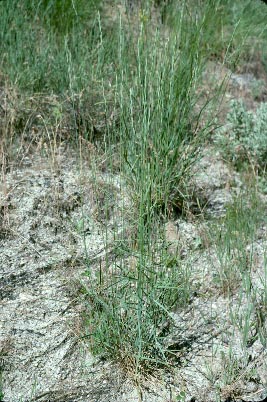Bluebunch Wheatgrass

Common Name(s):
Bluebunch Wheatgrass
Scientific Name:
Pseudoroegneria spicata (Pursh.)A. Löve
Scientific Name Synonyms:
Agropyron spicatum(Pursh.) Scribn. & J.G. Sm.
Symbol:
PSSP6
Description:
Life Span: Perennial
Origin: Native
Season: Cool
Growth Characteristics: An eErect bunchgrass, 1 to 2 ½ feet tall, often with short rhizomes. Growth begins in April and the plant stays green well into the summer. Regrowth occurs following fall rains. Reproduces from seeds, tillers, and rarely by rhizomes.
Seedhead: Slender spike up to 6 inches long; spikelets not imbricate to 1/8 imbricate, containing 4 to 8 florets; glumes acute; Bluebunch wheatgrass lemmas have awns 3/8 to ¾ inches long, divergent at maturity. It can also be awnless.
Leaves: Numerous, rolled in bud; blades flat or loosely rolled; glabrous or pubescent above, commonly 1/16 inch wide, tapering to the tip. Sheaths glabrous; ligules short, collar shaped, membranous; auricles small.
Ecological Adaptions:
Bluebunch wheatgrass has a wide spectrum of adaptations at elevations between 4,000 and 9,000 feet. It is found on all aspects on mountain slopes, benches, basins, or alluvial fans, and in valley bottoms. Bluebunch wheatgrass is one of the more widely distributed and useful species in Utah.
Soils: Adapted to a wide variety of soils, but is found mostly in well-drained, medium to coarse textures soils which vary in depth from shallow to very deep. It is found only in small quantities on fine-textured soils. It will tolerate moist soils, but is most abundant on dry soils.
Associated Species: Big sagebrush, Nevada bluegrass, Idaho fescue, sandberg bluegrass, and Douglas rabbitbrush.
Uses and Management:
The forage value of Bluebunch wheatgrass is excellent for cattle and horse, good for sheep, elk, and deer. It cures well and makes good standing winter feed. Season long, continuous grazing should be avoided. Research has found it can withstand early heavy use if it is used in a rotational grazing system.
An abundance of bluebunch wheatgrass is an indicator of well managed rangelands.

